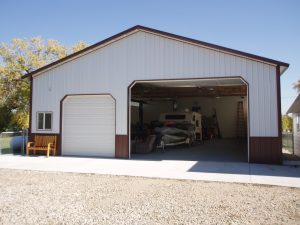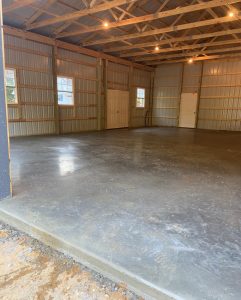I have a serious case of “like” for The Home Depot®. When my children were little, every time we got near one, they would start to chant (in unison), “Home Depot…..Home Depot”.
Yesterday morning I was in The Home Depot® at Grand Junction, Colorado. It was a special moment, when a gentleman came up to me (having perhaps recognized the red Hansen Pole Buildings shirt I was wearing) and told me he had purchased one of our buildings, and was constructing it now!
It isn’t very often I get to meet one of our clients, and even rarer when they are still building – so this was great fun for me.
He related to me how he was originally intending to order his new pole building kit package from Sutherlands® Lumber in Grand Junction. They had even provided him with plans, which he had submitted to the local Building Permit issuing authorities to acquire his Building Permit.
The Sutherlands® plans (which were approved by the Building Official) had a foundation composed of throwing a 90 pound bag of Quikrete® in the bottom of the hole. The pressure preservative treated column would then be placed, and another bag of Quikrete® dumped in around the post.
 It turns out the customer decided the Sutherlands® building was going to be inadequate. His only complaint at all with a Hansen Pole Building was the size of the holes and amount of concrete it took. Even then he admitted Hansen was a better buy, even with the extra concrete costs.
It turns out the customer decided the Sutherlands® building was going to be inadequate. His only complaint at all with a Hansen Pole Building was the size of the holes and amount of concrete it took. Even then he admitted Hansen was a better buy, even with the extra concrete costs.
The loyal readers of this column certainly will recall my railing against concrete cookies, in earlier posts: https://www.hansenpolebuildings.com/blog/2012/08/hurl-yourconcrete-cookies/ and https://www.hansenpolebuildings.com/blog/2014/03/concrete-cookies/
In my humble opinion, what is being purported to be adequate by Sutherlands® (whether the Building Official approved it or not) is close to criminal.
Our client’s building has 40’ span prefabricated wood roof trusses, with a double truss every 10 feet. In his 30 psf (pounds per square foot) roof load, it results in each truss bearing column having to support 6860 pounds of load. Added to the fun is a soil bearing capacity of only 1500 psf.
The International Building Codes (IBC) require footings to be a minimum of a nominal six inch thickness. So let’s explore the design solution promulgated by Sutherlands®.
At 90 pounds per bag of Quikrete® it would take about 1.65 bags to make a cubic foot. If this was all poured to a nominal six inch thickness as a footing pad beneath a column, it would roughly form a two foot diameter footing. Now granted, this is not how Sutherlands® would like to see it done, however we are going to give them the benefit of the doubt.
A two foot diameter footing has an area of 3.14 sft (square feet). Multiplying by the 1500 psf allowable foundation pressure, a pad such as this would support 4710 pounds….when it needs to support 6860 pounds – it is overstressed by nearly 50%!!!
Talking with a building kit supplier (such as a Sutherlands®) who is recommending bags of Quikrete® to backfill the bottom of a column hole? Might want to really think about the design being bought into.
Bagging it? Prepare for the possibility of a roof line with some humps and bumps in it, at a future date.
When people such as Sutherlands® provide under designed buildings, it gives our entire industry a bad name. I’m calling Sutherlands® out here – and challenging them to actually provide Code conforming pole building kit packages









Can you show me an example of a Sutherlands pole building with a roof line that has humps and bumps in it?
Larry ~ If you can provide me with addresses and contact information for your clients who have buildings similar in span, roof loading and soil bearing capacities to the example in the article – with the same foundation design, I’ll start calling around to them and I can guarantee there will be one or more of them who have had one or more columns settle and have a roof line which is no longer straight.
Even easier, provide engineer sealed calculations which prove the two sacks of premix concrete work to prevent settling, over turning and uplift for the building case in question and provides a Code conforming footing – I’ll gladly write an article giving Sutherlands (and the engineer) credit for the same.
Proper post frame building design all comes down to the Laws of Physics. To resist any given set of load conditions, the member (in this case the footing) must be able to adequately overcome the applied forces.
By the way – the example in my article turned out to be conservative in favor of Sutherlands. Here is the amount of concrete required to create a six inch thick, two foot diameter concrete footing: area = 3.14 X the radius squared = 3.14 X 1^2 = 3.14 square feet x 0.5′ thick = 1.57 cubic feet. 1.57 cubic feet divided by 27 (cubic feet in a cubic yard) = 0.058 cubic yards. A yard of concrete generally weighs about 3915 pounds (source: https://www.everything-about-concrete.com/density-of-concrete.html). 3915 pounds X 0.058 cubic yards = 227.65 pounds of concrete required to create a footing which is less than the amount proposed to be provided for the inadequately sized diameter in the case example.
Or, we could go right to the experts – Quikrete: https://www.quikrete.com/Calculator/Main.asp Type in 3.14 in the “Enter Number of Square Feet Desired” box. Click the “Calculate” button and for a 6 inch slab (same thickness as the minimum Code required footing thickness) it takes three 80 pound bags or four 60 pound bags (240 pounds of concrete).